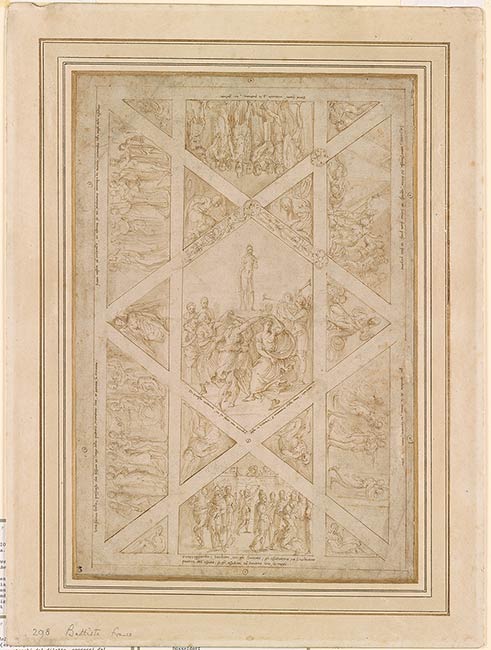
Franco’s ceiling illustrates the victory of the ancient city of Smyrna (modern Izmir) over the Sardians, the inhabitants of Sardis. When the Sardians offered to end their siege in return for the wives of Smyrna, a beautiful slave girl suggested that she and her companions go instead. The girls dressed the part and were welcomed by the Sardians, who, however, were taken prisoner when they were overcome by sleep. A festival to Venus was held every year thereafter in honor of the slave girls and the victory they had brought about. The theme of female supremacy gained through intelligence would have been appropriate for an ephemeral nuptial structure, underlining the bride’s ancestral lineage, or for a private setting, such as a palace ceiling celebrating a female patron. The drawing may have been made on the occasion of Duke Guidobaldo II della Rovere’s second marriage, to Vittoria Farnese, in 1548, for which Franco contributed substantially to the ephemeral decorations.1
Ruled diagonal lines form seven compartments containing the main episodes of the story. There are an additional ten small panels, eight of which contain Sardian prisoners, while those to either side of the central panel illustrate an angel and St. George and the Dragan, respectively. The narrative unfolds in a clockwise direction from the bottom with the events enumerated and inscribed.
John Gere observed that the group of dancing figures in the central episode is copied from Giulio Romano’s fresco in the Loggia della Grotta in the Palazzo del Te, Mantua, or taken from his preparatory study, now in the Albertina, Vienna.2
Footnotes:
- See Lauder 2004, 2: 484-85, no. 266DA.
- See Christie’s, London, 3 July 1984, lot 14; Albertina, Vienna, inv. 323.
Watermark: none visible through lining.
Ruled diagonal lines form seven compartments containing the main episodes of the story and ten smaller panels with single figures.
Inscribed above or below each scene, in pen and brown ink, beginning lower center and proceeding clockwise with the central episode last, "1. Guerreggiando i Sardiani, con gli Smirnei; gli assediarono, ne si volevano/partire dall'assedio; se gli assediati no[n] davano loro, le mogli; 2 Una serva bella, persuase che fossero in luogo delle padrone, mandare loro, et ottenne la dimanda; 3. furon vestite co[n] orname[n]ti, et adorne se ne andarono in campo de nimici incambio delle mogli delli assediati; 4. Dove furon ricevute p[er] le padrone, et godute; 5. la notte, come stanchi dal diletto, oppressi dal sonno furon presi, et fatti prigioni; 6. poi condotti da le donne, et huomini, legati [alla] citta; 7. Di questa vittoria, ne fu fatta una mirabil festa a Venere p[er] memoria delle donne; ognanno"; on mount, at lower left, in graphite, with the Chatsworth inventory number, "298 Battista Franco".
Devonshire, William Cavendish, Duke of, 1672-1729, former owner.
Devonshire, Andrew Robert Buxton Cavendish, Duke of, 1920-2004, former owner.
Selected references: Fellows Report, 1989, 340-41; Jaffé 1994, 791, no. 298; Lauder 2009, 148, note 112; New York 2019, 22-23.
65 Zeichnungen vor 1900: Dabei dies schönsten Neuerwerbungen 1984.
C.G. Boerner, Düsseldorf, N.L. 81, 1984, no. 3, repr. in color.
Ryskamp, Charles, ed. Twenty-First Report to the Fellows of the Pierpont Morgan Library, 1984-1986. New York : Pierpont Morgan Library, 1989, p. 340-341.
